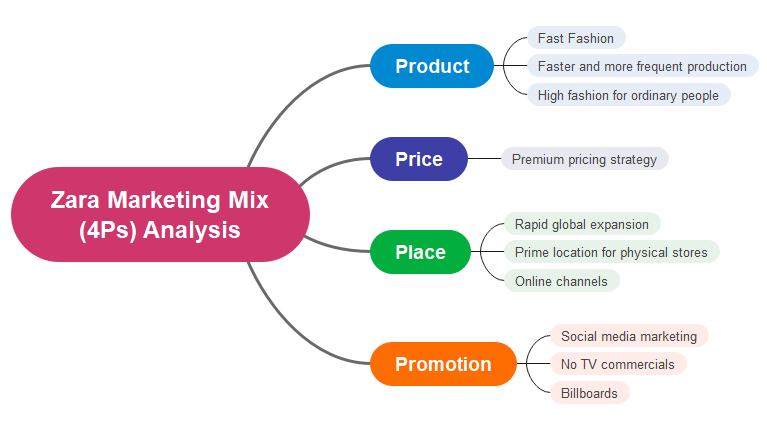Zara Marketing Mix (4Ps) Analysis

Introduction
Zara is a high fashion brand that is known around the world for its chic and stylish clothing and accessories. Many of today's fashion aficionados assume that Zara is a fairly new company because it had only been launched into the US market less than ten years ago, which was also about the time that it had skyrocketed to global fame. It was actually established in A Coruna, Galicia, Spain, in 1975 by Amancio Ortega and Rosalia Mera. The company stayed close to its roots for some time before it began to venture out into the world. Zara was a well-known brand that dominated the fashion industry in Spain and Portugal for years until they expanded to Delhi, India, which was the beginning of their rapid global expansion. Today, Zara has more than 2000 stores in 96 countries and a diverse client base.
Aside from providing superior quality apparel, Zara has also earned the reputation of being a 100% sustainable brand. They promote recycling and non-toxic materials, and they actively support numerous environmental advocacies. Zara is also credited in the fashion world for being one of the pioneers of fast fashion, which has massively revolutionized the industry.
Product Strategy of Zara
Zara didn't call it fast fashion at the time, but that was the strategy that Zara used when it entered the global fashion scene. From the start, the company's founder wanted to take a different approach to selling clothes. Retailers traditionally operated on a seasonal scheme, churning out massive amounts of apparel each season and selling overruns at a discount.
At Zara, what it does is to create new clothing designs all year round and only produce a limited number before moving on to the next designs. With these abbreviated production runs, designs get sold out faster, and there are virtually no leftovers. The higher number of designs makes for more variety and a wider range of choices for the customer. At the same time, the smaller amount of clothes per design also considerably increases its value for the customer because there will be fewer people who own the same outfit that it has just bought. In other words, there is higher exclusivity and, thus, more appeal.
Zara does all the manufacturing in its facilities instead of outsourcing. This ensures that it has complete control over the quality of its clothing, and it also cuts down a considerable amount of time on the overall production process.
Price Strategy of Zara
Considering the superior quality of Zara's clothing, which is comparable to most of the other high fashion brands today, most customers are pleasantly surprised that its pricing is very affordable compared to other apparel in its class. However, Zara products are still considered high fashion, and the company implements a premium pricing strategy, so the price tag might still be a bit expensive for the ordinary shopper.
Nevertheless, because one of the primary objectives of Zara is affordability, Zara always find ways to minimize production costs so that Zara can offer its products at lower prices and make them more accessible to the average customer who would like to wear great clothes without burning a hole in their pocket.
Place Strategy of Zara
It took a while for Zara to spread its horizons and put up outlets outside its home country of Spain, but once it started doing so, there was no turning back. Zara began its expansion in neighboring Portugal and eventually set up shop in India. Soon enough, they had stores all over the world, including flagship outlets in major world capitals like New York, London, Madrid, Rome, Paris, Saint Petersburg, Vladivostok, Tokyo, and Seoul. As of today, Zara operates 2,242 stores in 96 countries, and the global expansion is still going on.
Zara has also actively pursued online channels of selling. Aside from their official website, where you can browse and purchase most of its products, Zara has also partnered with several multi-brand online outlets, effectively increasing its reach into the global market. Online channels are also a great way to market to the younger crowd that spends a lot of time on social media. Its strong online presence is one of the reasons why Zara is very popular with millennials.
Promotion Strategy of Zara
Another reason why Zara's marketing strategies are so unique is because it does not spend much on advertising. Rival brands shell out millions of dollars on multiple advertising schemes, while Zara doesn't even have TV commercials. Zara capitalizes on very inexpensive but highly effective social media advertising strategies. If Zara needs to promote an event or a new clothing design, all it has to do is post a Facebook status, and its 30 million followers can read it and spread the word. If that is not enough, Zara can also post a few pictures on Instagram for its 45 million followers to like and share.
Zara does spend on billboard advertising. This might be expensive, but its ads are very engaging and specifically target the youth, which makes up the bulk of its clientele. It is also worth mentioning that Zara does not place its logo on any of its products. Zara believes it is an unnecessary expense and instead directs its funds on opening new stores in prime locations around the world, which is an approach that has worked incredibly well for it so far.
Zara Marketing Mix (4Ps) Analysis Mind Map
The strategies involved in the Zara marketing mix are definitely different, if not one-of-a-kind. When you take a look at Zara, the strategies seem so simple and so effective, yet it's a wonder that no one has thought of them or tried them before. We have already discussed the components of the Zara marketing mix above, but it would help to understand them better if they were summarized in a diagram, just like in the following mind map.
 View, edit, and download this template in EdrawMind >>
View, edit, and download this template in EdrawMind >>
Product
- Fast Fashion
- Faster and more frequent production
- High fashion for ordinary people
Price
- Premium pricing strategy
Place
- Rapid global expansion
- Prime location for physical stores
- Online channels
Promotion
- Social media marketing
- No TV commercials
- Billboards
Key Takeaways
The Zara marketing mix is an interesting blend of innovative marketing strategies that have delivered extremely successful results for the company so far. Zara is a very customer-focused brand, and its goal is to produce a controlled quantity of trendy clothing quickly and at prices that are affordable to the ordinary customer.
Its strategy is a win-win for everyone, and it won't be surprising if more clothing companies adopt and implement similar strategies in the future. In fact, the Zara marketing mix can be an excellent model for you to create a similar strategy for your venture.
There's actually an easy way to create your own marketing mix around the 4Ps, and that is by using the pre-built templates of EdrawMind. These templates are so easy to use, you basically just have to open them, enter your ideas in the appropriate spaces, and you will soon have a marketing mix that looks like it was professionally done. You even have the option of using the software's collaboration feature if you want to work with your team on creating mind maps. Just send them the link, and they will be able to access the same files that you are working on, and everyone will be able to see all updates in real-time.






